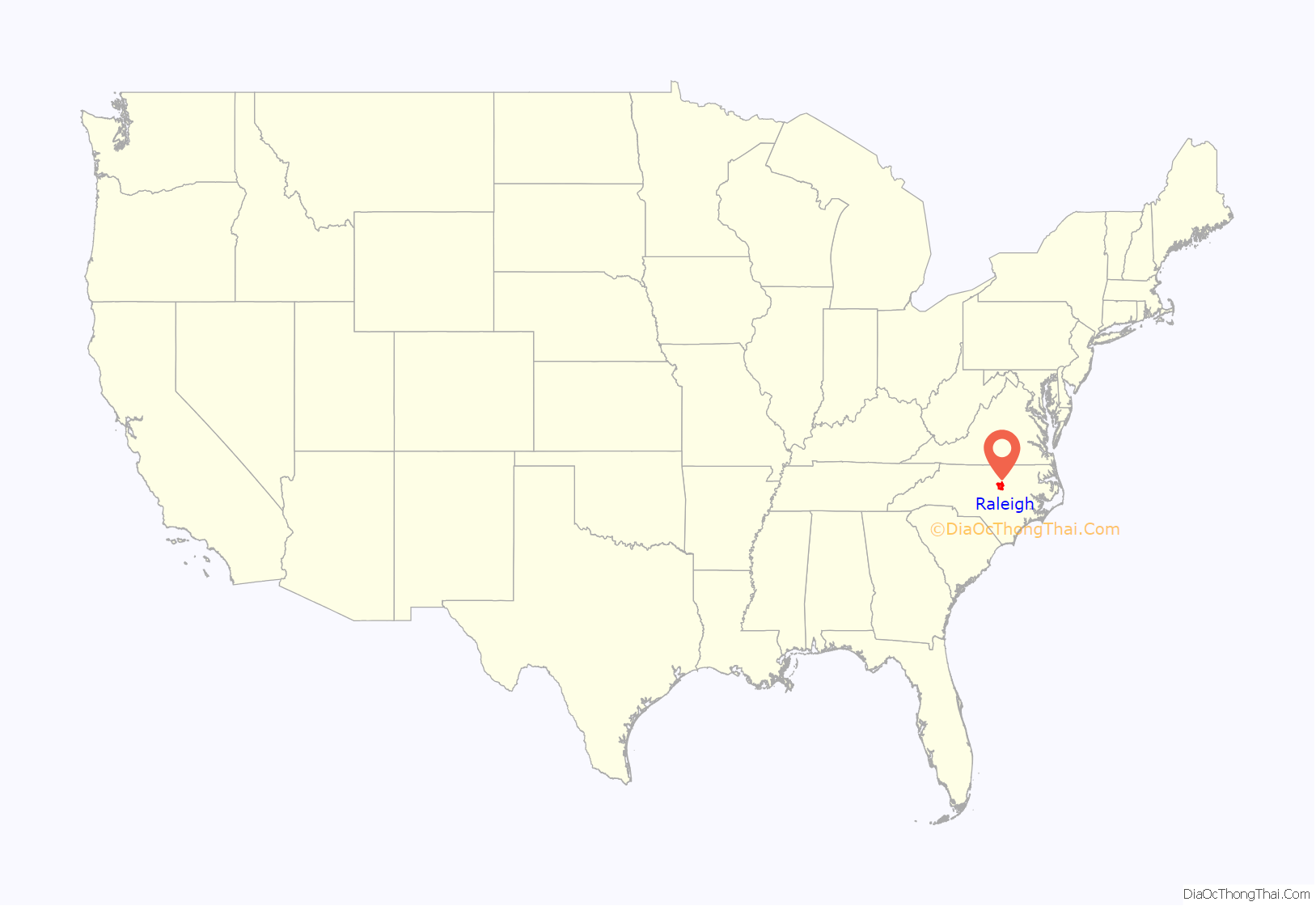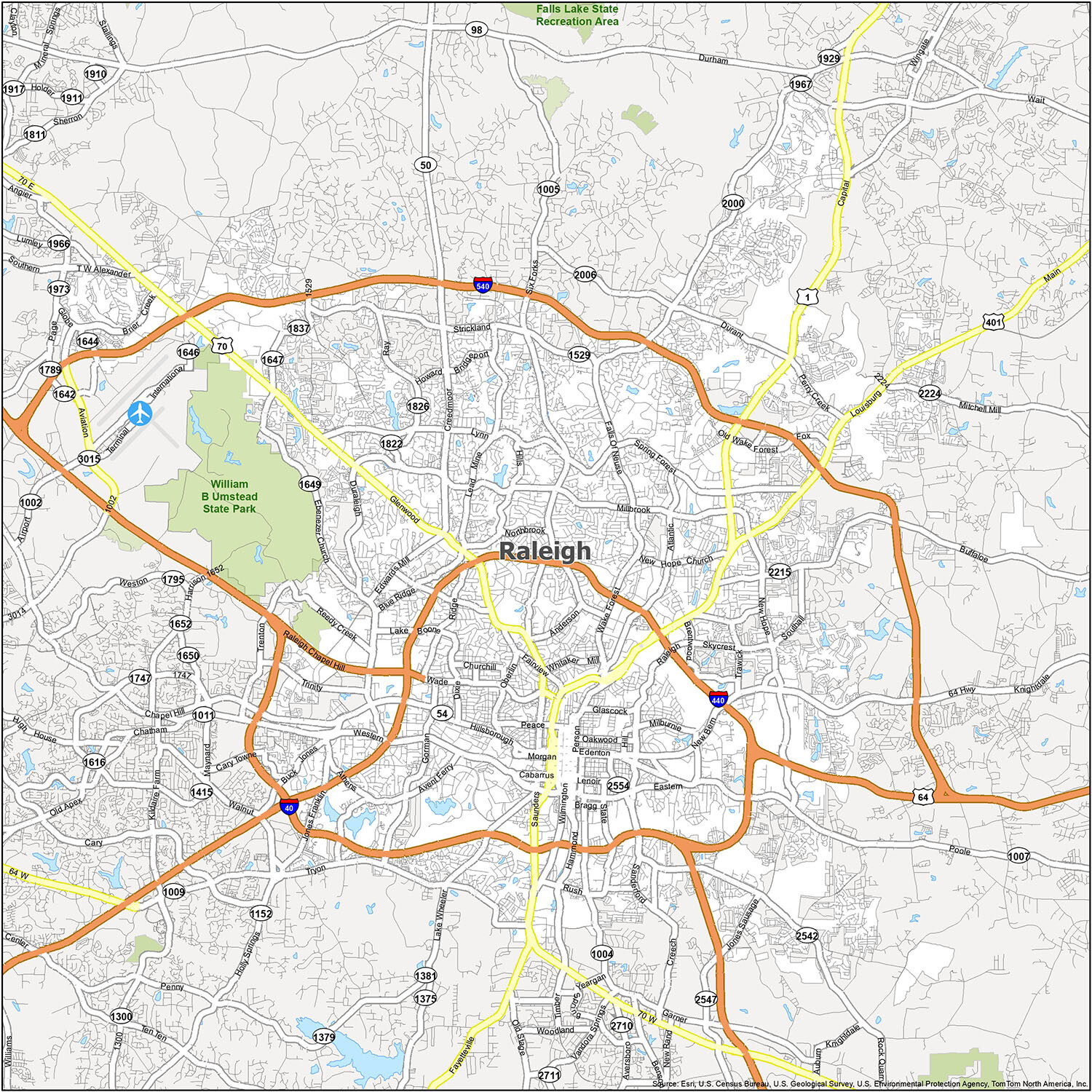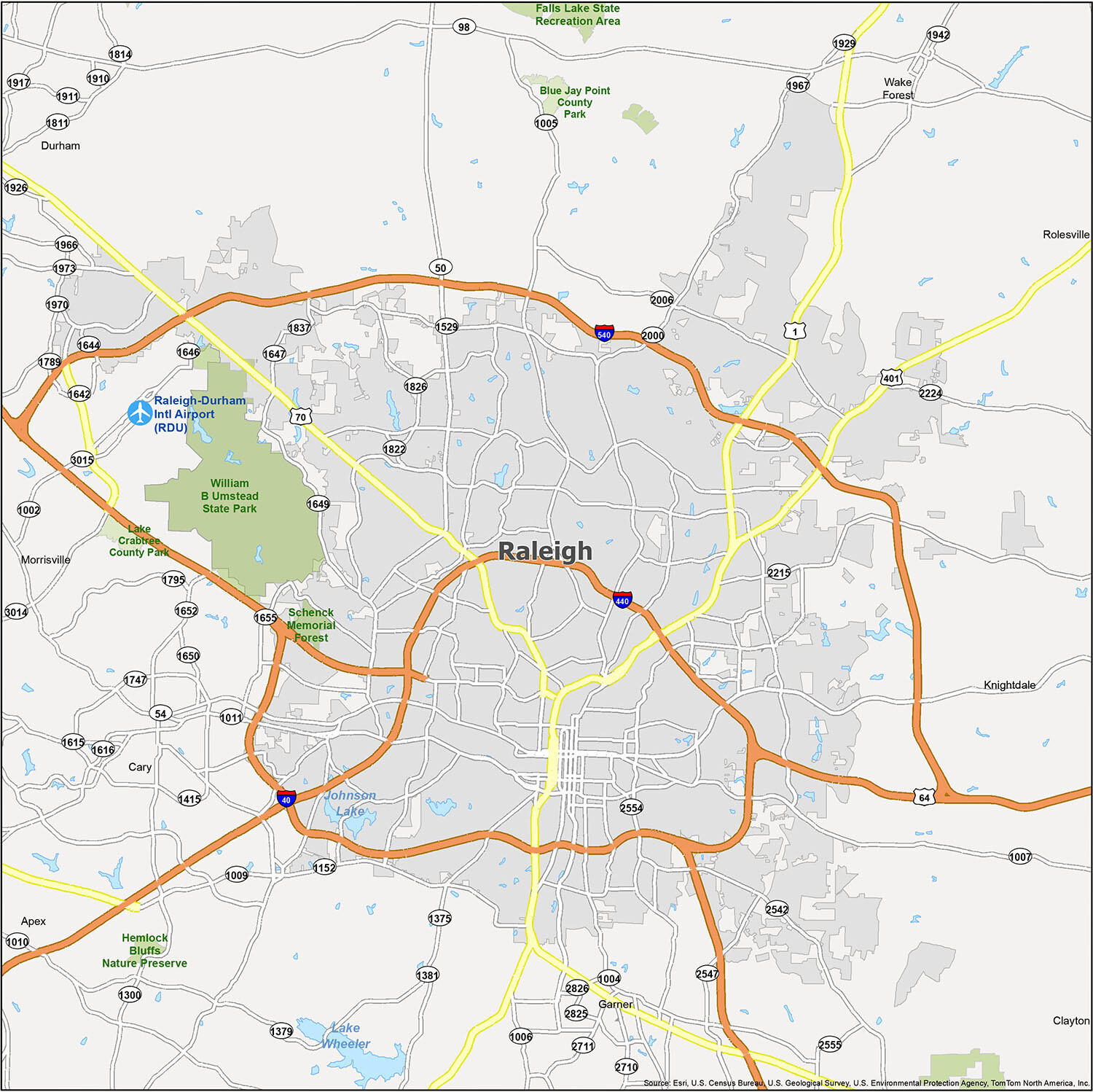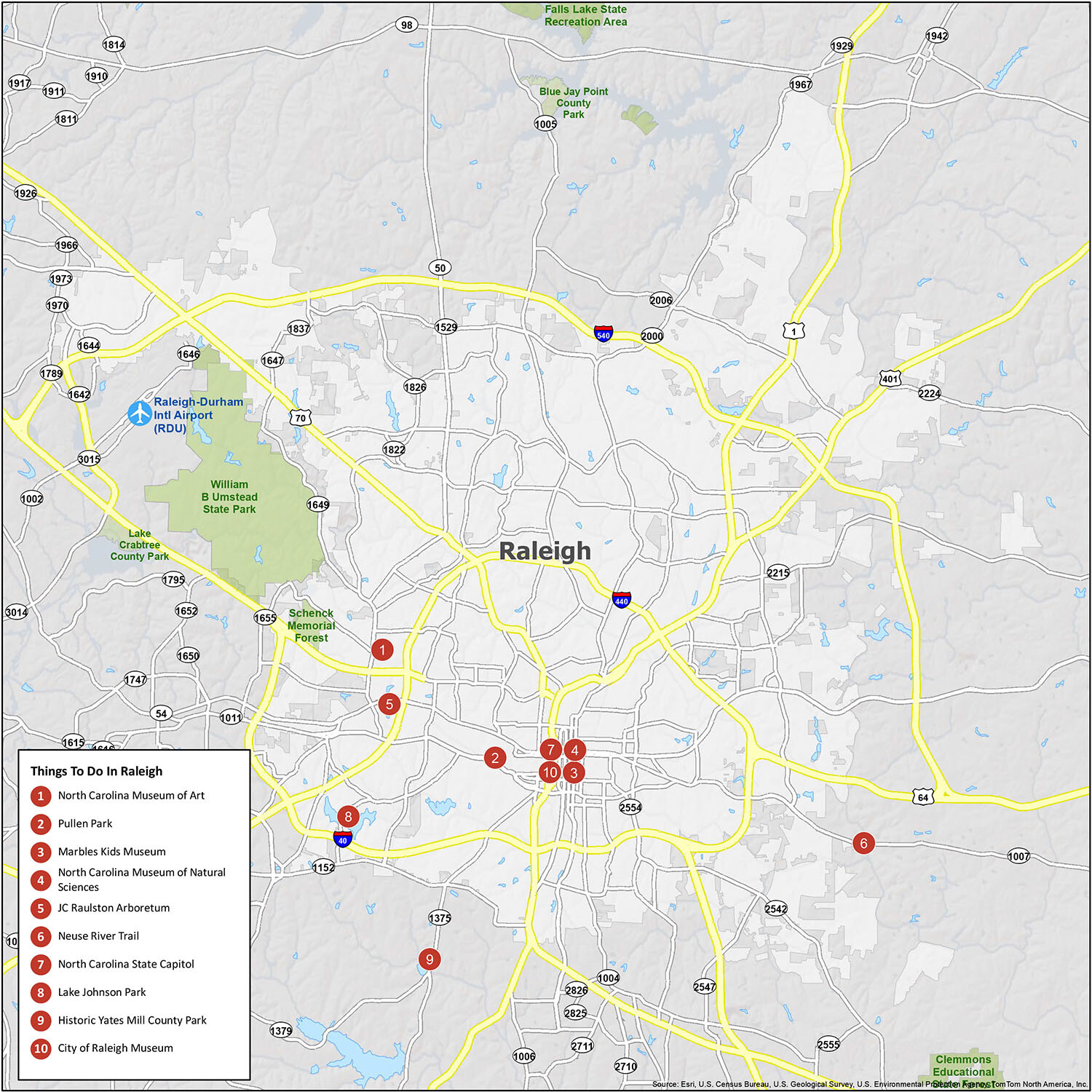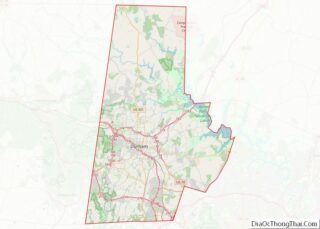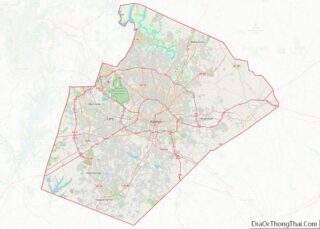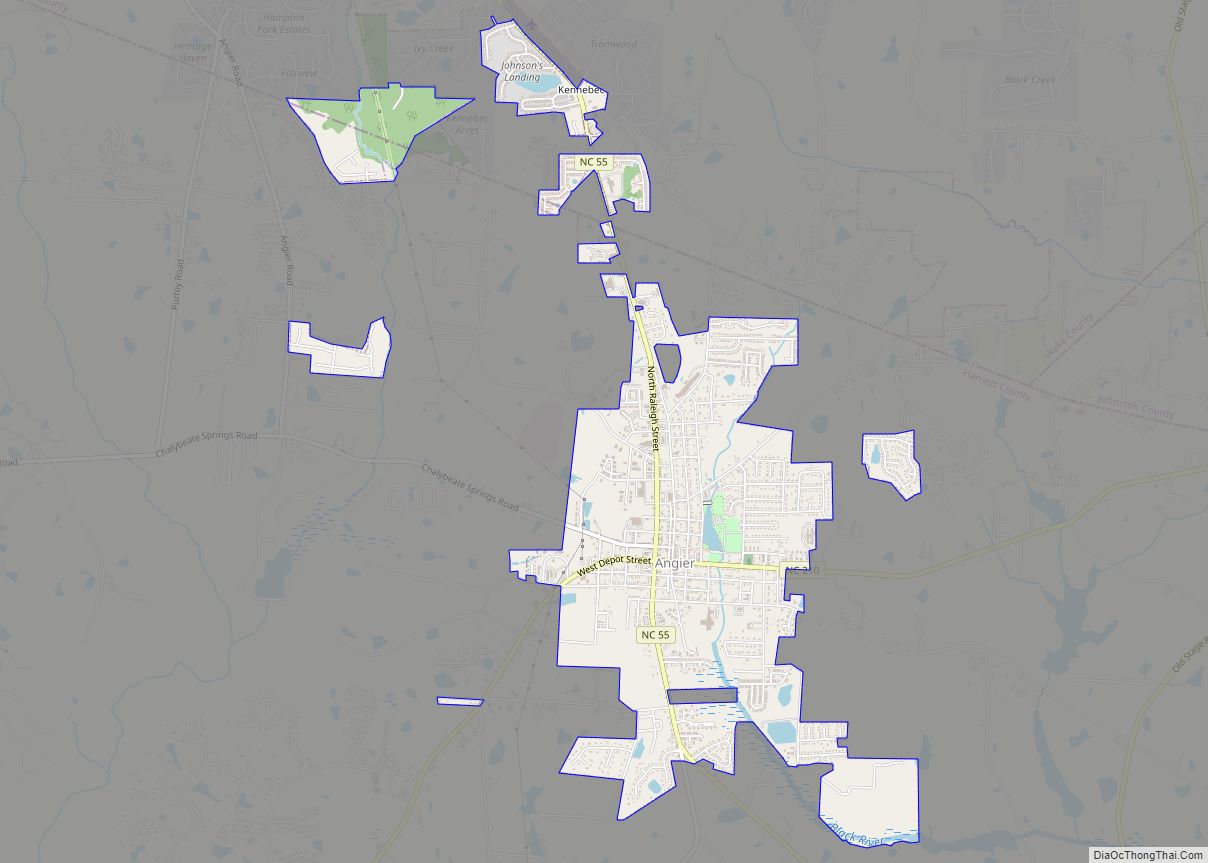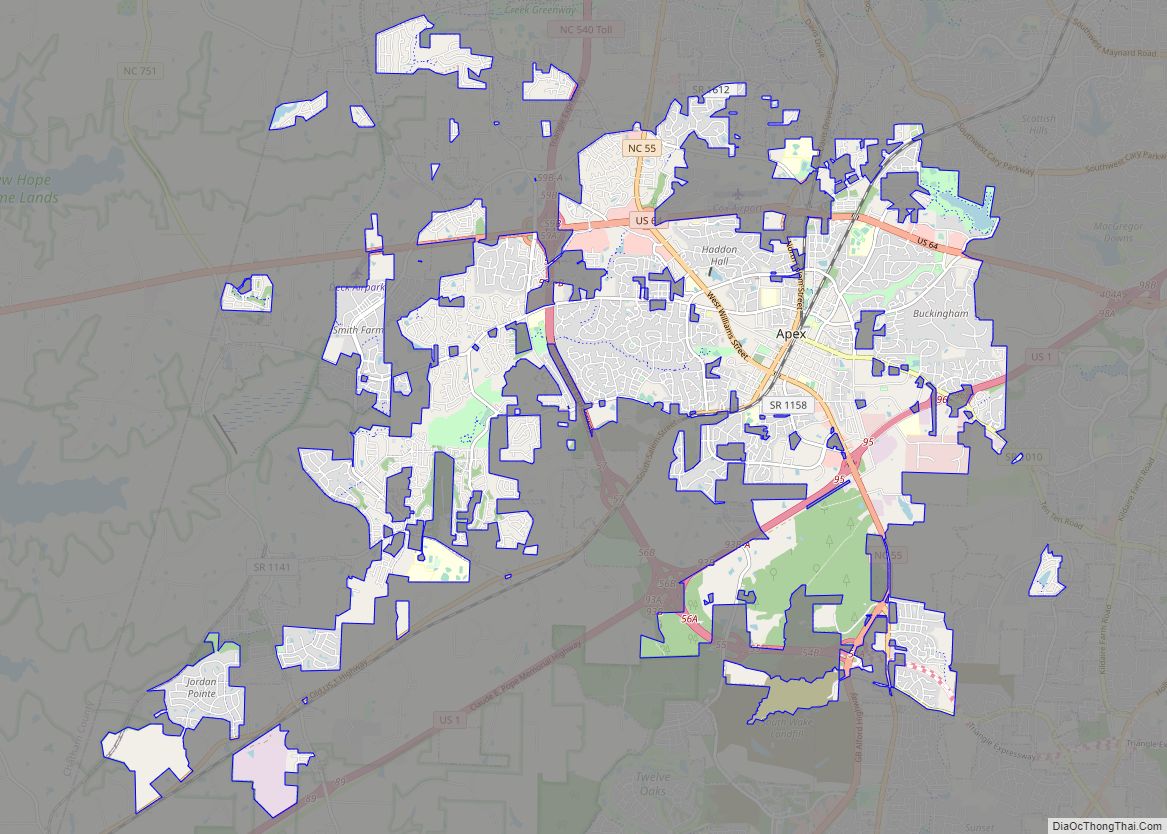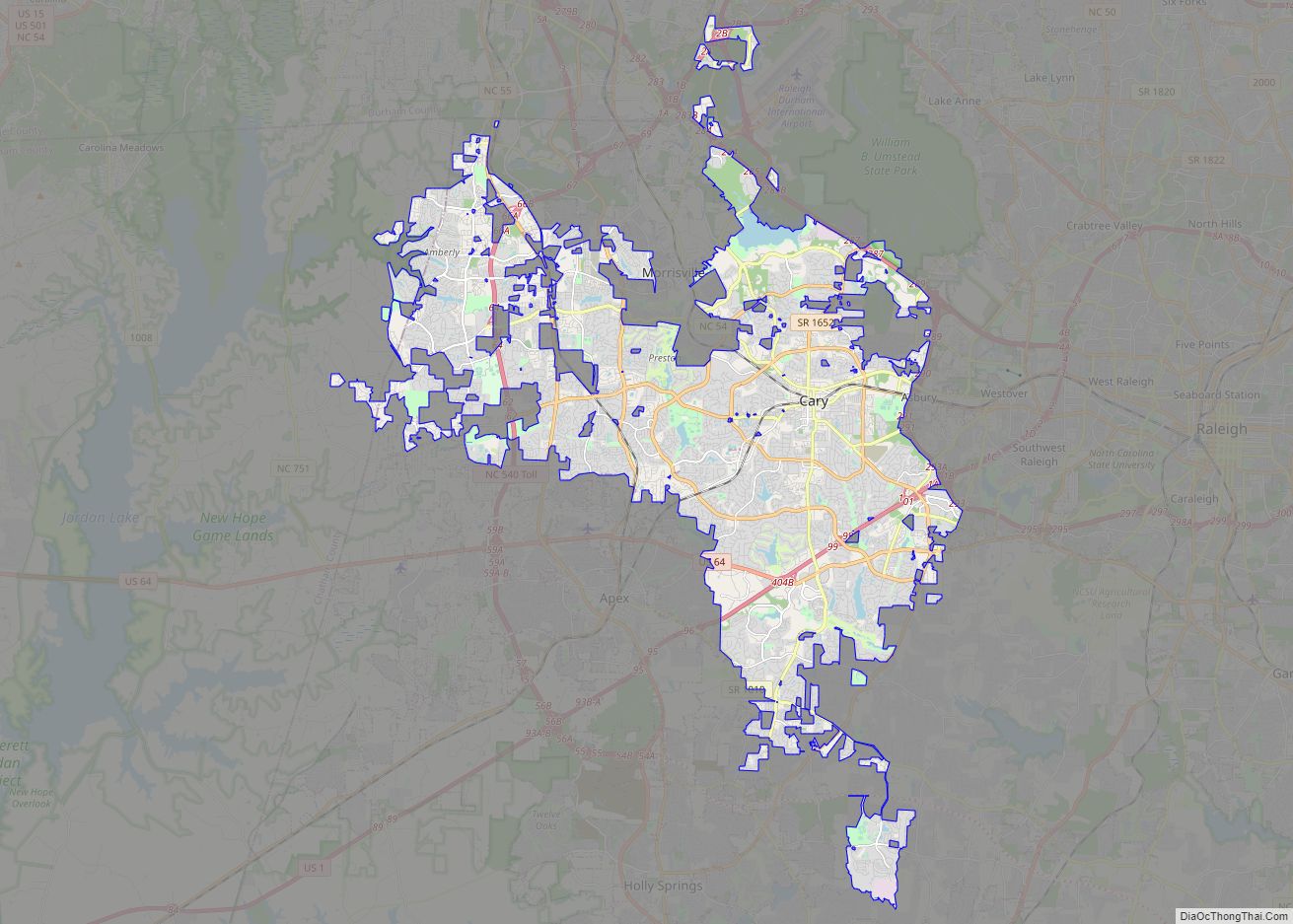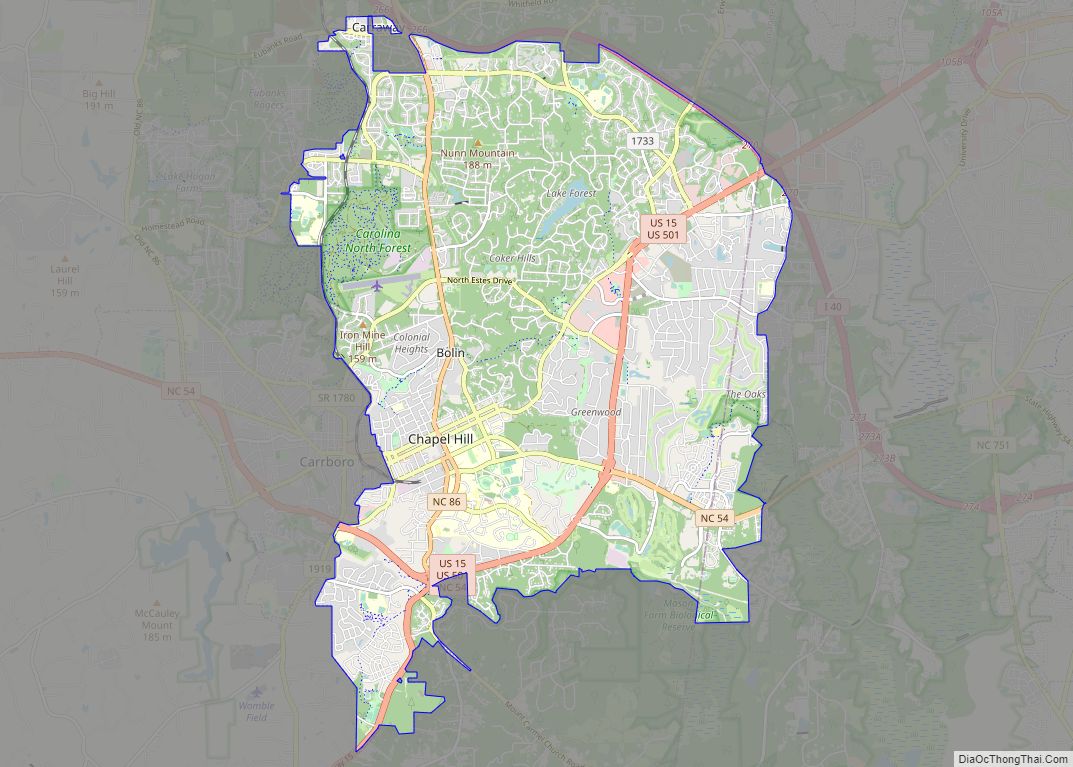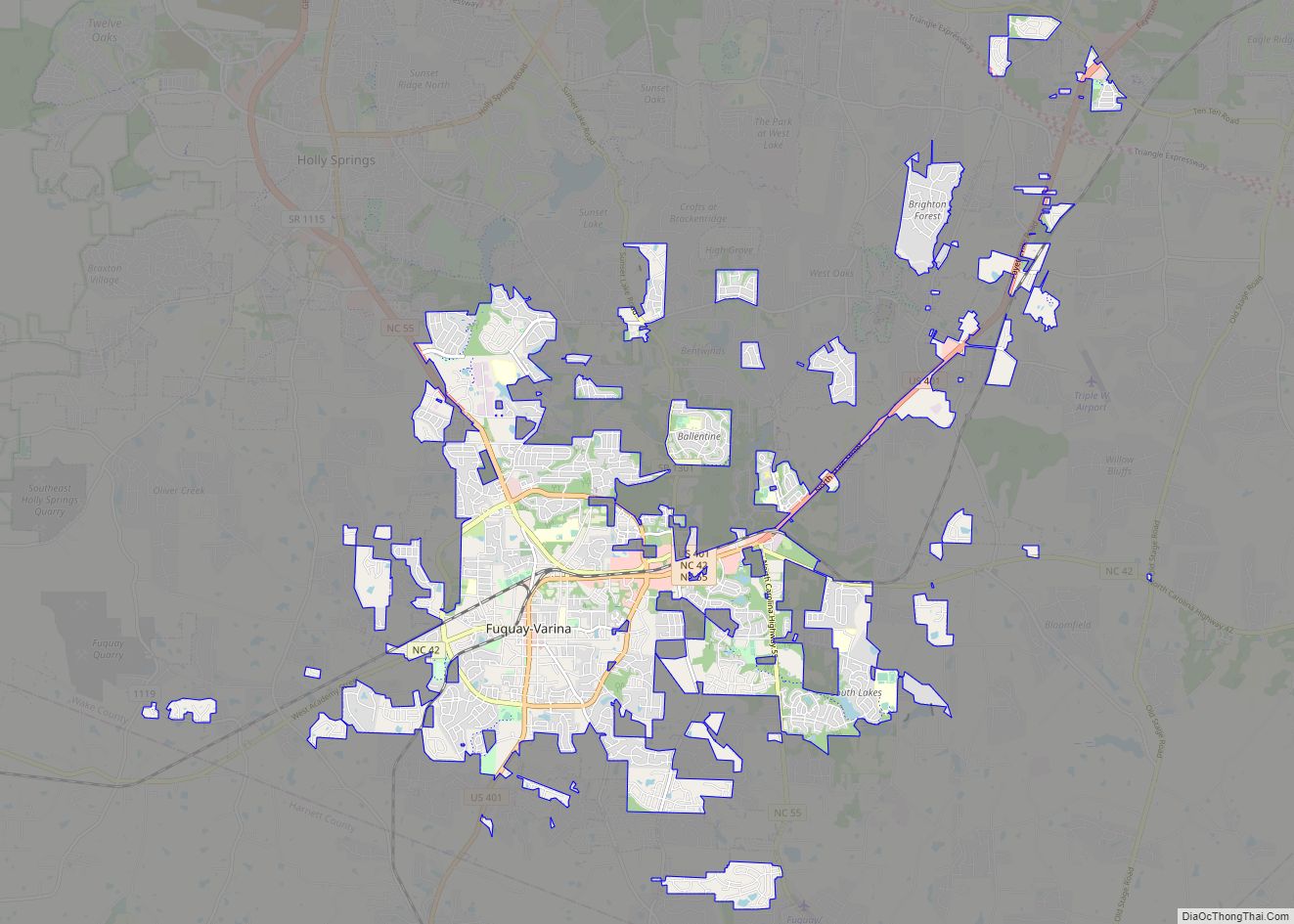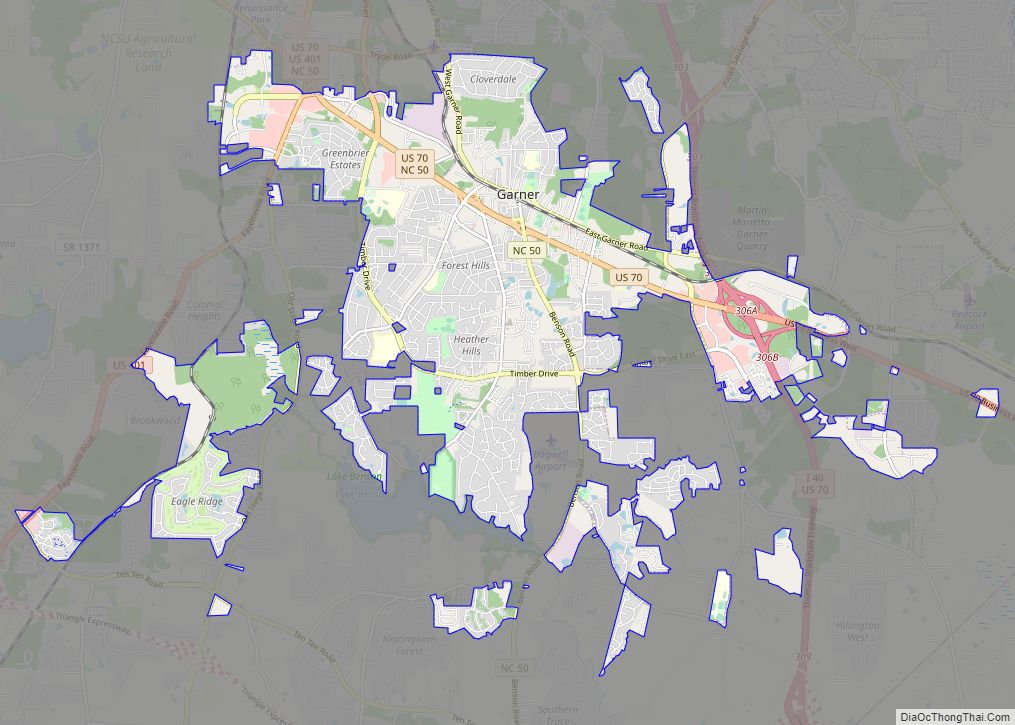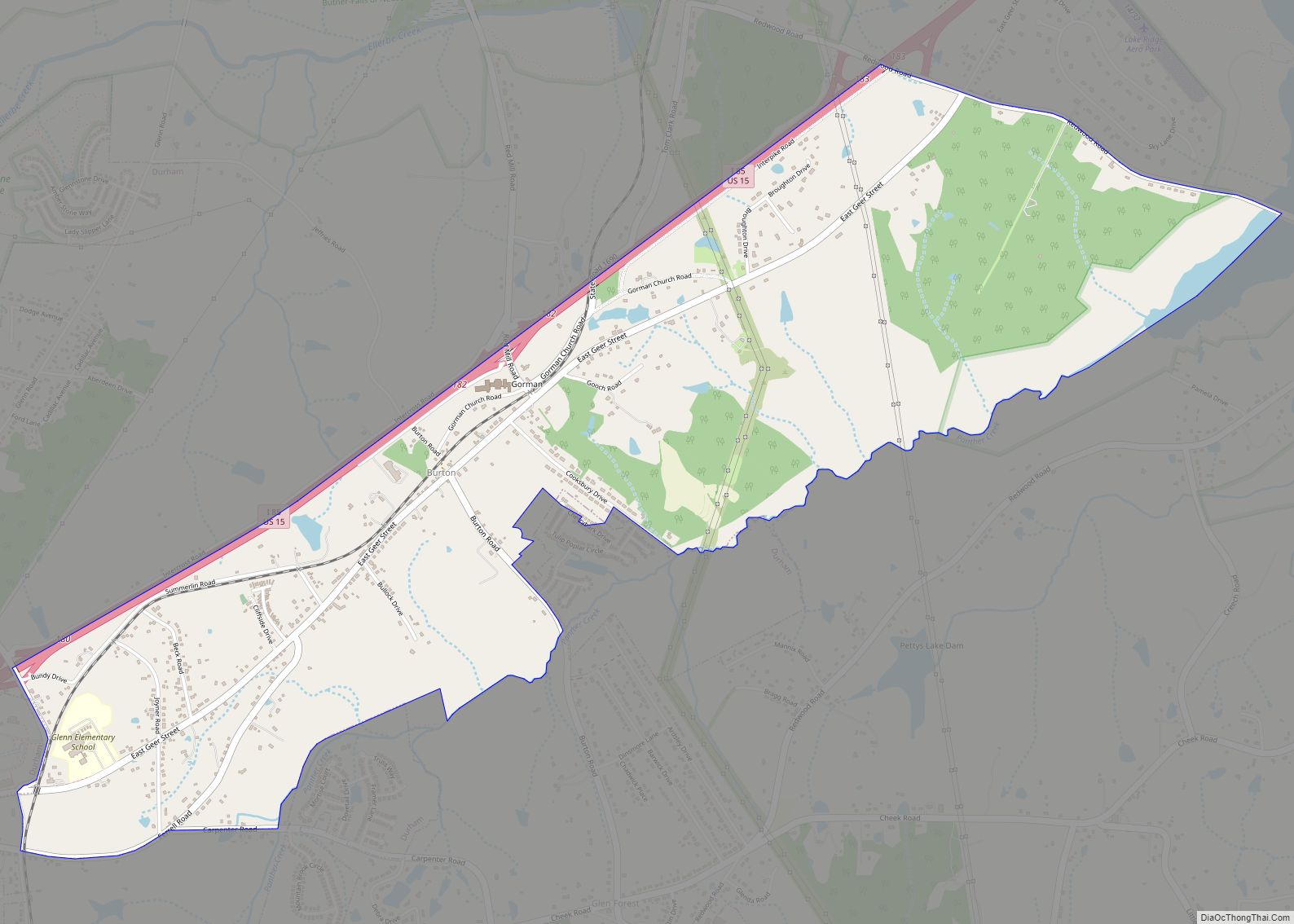Raleigh (/ˈrɑːli/; RAH-lee) is the capital city of the state of North Carolina and the seat of Wake County in the United States. It is the second-most populous city in North Carolina, after Charlotte. Raleigh is the tenth-most populous city in the Southeast, the 41st-most populous city in the U.S., and the largest city of the Research Triangle metro area. Raleigh is known as the “City of Oaks” for its many oak trees, which line the streets in the heart of the city. The city covers a land area of 147.6 sq mi (382 km). The U.S. Census Bureau counted the city’s population as 467,665 in the 2020 census. It is one of the fastest-growing cities in the United States. The city of Raleigh is named after Sir Walter Raleigh, who established the now-lost Roanoke Colony in present-day Dare County.
Raleigh is home to North Carolina State University (NC State) and is part of the Research Triangle together with Durham (home of Duke University and North Carolina Central University) and Chapel Hill (home of the University of North Carolina at Chapel Hill). The name of the Research Triangle (often shortened to the “Triangle”) originated after the 1959 creation of Research Triangle Park (RTP), located in Durham and Wake counties, among the three cities and universities. The Triangle encompasses the U.S. Census Bureau’s Raleigh-Durham-Cary Combined Statistical Area (CSA), which had an estimated population of 2,037,430 in 2013. The Raleigh Metropolitan Statistical Area had an estimated population of 1,390,785 in 2019.
Most of Raleigh is located within Wake County, with a small portion extending into Durham County. The towns of Cary, Morrisville, Garner, Clayton, Wake Forest, Apex, Holly Springs, Fuquay-Varina, Knightdale, Wendell, Zebulon, and Rolesville are some of Raleigh’s primary nearby suburbs and satellite towns.
Raleigh is an early example in the United States of a planned city. Following the American Revolutionary War when the U.S. gained independence, the area was chosen as the site of the state capital in 1788 and incorporated in 1792 as such. The city was originally laid out in a grid pattern with the North Carolina State Capitol at the center, in Union Square. During the American Civil War, the city was spared from any significant battle. It fell to the Union in the closing days of the war and struggled with the economic hardships in the postwar period, related to the reconstitution of labor markets, over-reliance on agriculture and the social unrest of the Reconstruction Era. The establishment of the Research Triangle Park (RTP) in 1959 helped create tens of thousands of jobs in the fields of science and technology. By the early 21st century, Raleigh had become one of the fastest-growing cities in the United States.
| Name: | Raleigh city |
|---|---|
| LSAD Code: | 25 |
| LSAD Description: | city (suffix) |
| State: | North Carolina |
| County: | Durham County, Wake County |
| Elevation: | 315 ft (96 m) |
| Land Area: | 148.54 sq mi (384.73 km²) |
| Water Area: | 1.07 sq mi (2.77 km²) |
| Population Density: | 3,148.33/sq mi (1,215.57/km²) |
| Area code: | 919, 984 |
| FIPS code: | 3755000 |
| GNISfeature ID: | 1024242 |
| Website: | raleighnc.gov |
Map of Raleigh, NC
Are you searching for a map of Raleigh, North Carolina? If you answered yes, then we have exactly what you’re looking for! Check out our road map, a list of things to do, and an interactive map of Raleigh.
Raleigh is located in central North Carolina. Not only is it the capital city of the state, but it’s also the second-largest city in the state. With this map collection, you can discover the best of what the city has to offer.
Raleigh is a must-see city in NC and is the perfect place for tourists. Start exploring the best things to do in Raleigh, including museums, green spaces, hotels, and more in the interactive map below.
Map of Raleigh, NC
Discover the beauty of Raleigh, North Carolina with our comprehensive map collection. From road maps to interactive maps to a list of things to do, you’ll find everything you need to make the most of your trip to this vibrant city.
Explore the many attractions that Raleigh has to offer, including museums, green spaces, hotels, and more. With our interactive map, you can easily find the best places to visit and make sure you don’t miss out on any of the city’s amazing offerings.
Whether you’re looking for a road map of Raleigh or a comprehensive list of things to do, we have you covered. Check out our map collection and start planning your trip to this vibrant city today!
Online Interactive Map
Click on ![]() to view map in "full screen" mode.
to view map in "full screen" mode.
This interactive map is perfect for anyone who wants to explore Raleigh, North Carolina with up-to-date information. You can search for restaurants and attractions, get bike routes, and even find out which hotels are conveniently located near your destination. Get around Raleigh and its surrounding areas quickly and easily with our interactive map.
Raleigh location map. Where is Raleigh city?
Raleigh Road Map
Raleigh is a city that offers a lot of unique things to do and this road map is the perfect tool to help you find your way around. Browse through the streets in a convenient color-coded scheme and get directions to your destination. Not only is this map a convenient way to navigate around the town, but it’s all in one printable page for extra convenience. For travel outside the city, refer to the North Carolina road map for highway information. Interstate Highways: I-40, I-440, I-540; US Highways: 1, 50, 54, 64, 70, 401, Raleigh Durham Hwy, Spring Forest Hwy, Wake Forest Hwy; Expressways/Parkways: Brier Creek Pky, Corporation Pky, Raleigh Chapel Hill Expy; Major Roads: Capital Blvd, Chapel Hill Rd, Creedmoor Rd, Dawson St, Falls Of Neuse Rd, Fayetteville Rd, Fox Rd, Glenwood Ave, Hillsborough St, Louisburg Rd, Mcdowell St, Millbrook Rd, Morgan St, New Bern Ave, Old Wake Forest Rd, Saunders St, Six Forks Rd, Triangle Town Blvd, Wade Ave, Wake Forest Rd, Wilmington St.
Exploring Raleigh for the first time? Check out this reference map to get to know the best of the city. It shows state parks, forests, preserves, airports, and much more. This map can help you navigate through Raleigh with ease. Here’s a quick overview of the places you can explore:
- Airports: Raleigh-Durham International Airport (RDU)
- Cities: Durham, Raleigh
- Towns: Apex, Cary, Clayton, Garner, Knightdale, Morrisville, Rolesville, Wake Forest
- Forests/Parks: Hemlock Bluffs Nature Preserve, Lake Crabtree County Park, Schenck Memorial Forest, William B Umstead State Park
10 things to do in Raleigh city
Raleigh is a great place to visit and explore. From the North Carolina Museum of Art to the Neuse River Trail, there are plenty of wonderful attractions to explore. Whether you’re looking for a day trip or a weekend getaway, Raleigh has something for everyone.
Discover the best of Raleigh and explore its fascinating attractions! Visit the North Carolina Museum of Art, take a stroll through Pullen Park, and explore the Marbles Kids Museum. For nature lovers, there’s the JC Raulston Arboretum and the Neuse River Trail. History buffs will enjoy the North Carolina State Capitol and Historic Yates Mill County Park, while the City of Raleigh Museum provides a great insight into the city’s past. Whatever your interests, Raleigh has something for everyone!
Raleigh city Satellite Map
Geography
According to the United States Census Bureau, the city of Raleigh occupies a total area of 144.0 sq mi (373.0 km), of which 142 sq mi (369 km) is land and 0.97 sq mi (2.5 km), or 0.76%, is covered by water. The Neuse River flows through the northeastern corner of the city.
Raleigh is located in the northeast central region of North Carolina, where the Piedmont and Atlantic coastal plain regions meet. This area is known as the “fall line” because it marks the elevation inland at which waterfalls begin to appear in creeks and rivers. As a result, most of Raleigh features gently rolling hills that slope eastward toward the state’s flat coastal plain.
The city of Raleigh is located 24 mi (39 km) southeast of Durham, 63 mi (101 km) northeast of Fayetteville, 131 mi (211 km) northwest of Wilmington, 165 mi (266 km) northeast of Charlotte, and 155 mi (249 km) southwest of Richmond, Virginia. A small portion of Raleigh is located in Durham County, North Carolina.
Cityscape
Raleigh is divided into several major geographic areas, each of which use a Raleigh address and a ZIP code that begins with the digits 276. PNC Plaza, formerly known as RBC Plaza, is the largest and tallest skyscraper in the city of Raleigh. The tower rises to a height of 538 ft (164 m), with a floor count of 34.
One common division of Raleigh is to differentiate the central part of the city, which lies inside of the circumferential highway known as the Raleigh Beltline (I-440 and I-40) from areas outside of the Beltline. The area inside of the beltline includes the entirety of the central business district known as Downtown Raleigh, as well as several more residential areas surrounding it.
The downtown area is home to historic buildings such as the Sir Walter Raleigh Hotel built in the early 20th century, the restored City Market, the Fayetteville Street downtown business district (which includes the PNC Plaza and Wells Fargo Capitol Center buildings), as well as the North Carolina Museum of History, North Carolina Museum of Natural Sciences, North Carolina State Capitol, William Peace University, the City of Raleigh Museum, Raleigh Convention Center, Shaw University, Campbell University School of Law, and St. Augustine’s College. In the 2000s, an effort by the Downtown Raleigh Alliance was made to separate this area of the city into five smaller districts: Fayetteville Street, Moore Square, Glenwood South, Warehouse (Raleigh), and Capital District (Raleigh).
Some of the names have become commonplace among locals, such as the Warehouse District, Fayetteville Street, and Glenwood South. Other neighborhoods lying inside the Beltline include Forest Park, Boylan Heights, Country Club Hills, Coley Forest, Five Points, Budleigh, Glenwood-Brooklyn, Hayes Barton Historic District, Moore Square, Mordecai (home to the historic Mordecai House), Rochester Heights, South Park, Rosengarten Park, Belvidere Park, Woodcrest, Oberlin Village, and Historic Oakwood. These neighborhoods were typically built before World War II, and roughly correspond to the extent of the city of Raleigh before the population boom of the latter half of the 20th century led to growth of the city limits beyond the historic urban core.
Midtown Raleigh is a relatively new term used to describe the residential and commercial area lying on the northside of the I-440 Beltline and is part of North Raleigh. It is roughly framed by Glenwood/Six Forks Road to the West, Wake Forest Road to the East, and Millbrook Road to the North. It includes shopping centers such as North Hills and Crabtree Valley Mall. It also includes North Hills Park and part of the Raleigh Greenway System. The term was coined by the Greater Raleigh Chamber of Commerce, developer John Kane and planning director Mitchell Silver. The News & Observer newspaper started using the term for marketing purposes only. The Midtown Raleigh Alliance was founded on July 25, 2011, as a way for community leaders to promote the area. The center of the area, especially around the North Hills development at the junction of Six Forks Road and the Beltline, is experiencing rapid urbanization as several high-rise buildings have been built since 2010.
East Raleigh is situated roughly from Capital Boulevard near the I-440 beltline to New Hope Road. Most of East Raleigh’s development is along primary corridors such as U.S. 1 (Capital Boulevard), New Bern Avenue, Poole Road, Buffaloe Road, and New Hope Road. Neighborhoods in East Raleigh include Hedingham, Longview, Lockwood, Madonna Acres, New Hope, Thompson-Hunter and Wilder’s Grove. The area is bordered to the east by the town of Knightdale.
West Raleigh lies along Hillsborough Street and Western Boulevard. The area is bordered to the west and south by Cary. It is home to North Carolina State University, Meredith College, Pullen Park, Pullen Memorial Baptist Church, the Islamic Association of Raleigh, Village District, Lake Johnson, the North Carolina Museum of Art and historic Saint Mary’s School. Primary thoroughfares serving West Raleigh, in addition to Hillsborough Street, are Avent Ferry Road, Blue Ridge Road, and Western Boulevard. The PNC Arena is also located here adjacent to the North Carolina State Fairgrounds. These are located approximately 2 miles from Rex Hospital.
North Raleigh is an expansive, diverse, and fast-growing suburban area of the city that is home to established neighborhoods to the south along with many newly built subdivisions and along its northern fringes. The area generally falls North of Millbrook Road. It is primarily suburban with large shopping areas. Primary neighborhoods and subdivisions in North Raleigh include Bartons Creek Bluffs, Bedford, Bent Tree, Black Horse Run, Brier Creek, Brookhaven, Coachman’s Trail, Crossgate, Crosswinds, Dominion Park, Durant Trails, Ethan’s Glenn, Falls River, Greystone Village, Harrington Grove, Hidden Valley, Lake Park, Long Lake, North Haven, North Ridge, Oakcroft, Shannon Woods, Six Forks Station, Springdale Estates, Stonebridge, Stone Creek, Stonehenge, Summerfield, The Sanctuary, Valley Estates, Wakefield, Weathersfield, Windsor Forest, and Wood Valley. The area is served by a number of primary transportation corridors including Glenwood Avenue U.S. Route 70, Interstate 540, Wake Forest Road, Millbrook Road, Lynn Road, Six Forks Road, Spring Forest Road, Creedmoor Road, Leesville Road, Norwood Road, Strickland Road, and North Hills Drive.
South Raleigh is located along U.S. 401 south toward Fuquay-Varina and along US 70 into suburban Garner. This area is the least developed and least dense area of Raleigh (much of the area lies within the Swift Creek watershed district, where development regulations limit housing densities and construction). The area is bordered to the west by Cary, to the east by Garner, to the southwest by Holly Springs and the southeast by Fuquay-Varina. Neighborhoods in South Raleigh include Eagle Creek, Renaissance Park, Lake Wheeler, Swift Creek, Carolina Pines, Rhamkatte, Riverbrooke, and Enchanted Oaks.
Southeast Raleigh is bounded by downtown on the west, Garner on the southwest, and rural Wake County to the southeast. The area includes areas along Rock Quarry Road, Poole Road, and New Bern Avenue. Primary neighborhoods include Abbington Ridge, Pearl Ridge, Chastain, Chavis Heights, Raleigh Country Club, Southgate, Kingwood Forest, Rochester Heights, Emerald Village, Worthdale and Biltmore Hills. Coastal Credit Union Music Park (formerly Time Warner Cable Music Pavilion, Alltel Pavilion and Walnut Creek Amphitheatre) is one of the region’s major outdoor concert venues and is located on Rock Quarry Road. Shaw University is located in this part of the city. Starting in 2020, large tracts of formerly unoccupied land along Rock Quarry Road between New Hope Road and Barwell Road, and between Barwell Road and Battle Bridge Road, have been cleared for new developments.
Climate
Like much of the Southeastern United States, Raleigh has a humid subtropical climate (Köppen Cfa). Winters are generally cool, with a normal January daily mean temperature of 41.9 °F (5.5 °C). On average, there are 69 nights per year that drop to or below freezing, and only 2.7 days that fail to rise above freezing. Raleigh receives an average annual rainfall of 46.07 in (117.0 cm). Annual and monthly temperature and precipitation data are in chart below, based on 1991–2020 climate data. February is the driest month, with an average of 2.78 in (70.6 mm) of precipitation. Precipitation is well distributed around the year, with a slight maximum between July and September, owing to generally frequent, sometimes heavy, showers and thunderstorms, and the threat of tropical weather systems (primarily in from August to early October) bringing heavy rainfall. Summers are hot and humid, with a normal July daily mean temperature of 80.5 °F (26.9 °C). There are 48 days per year with highs at or above 90 °F (32 °C). Autumn is similar to spring overall but has fewer days of rainfall, but greater potential for extremely heavy rainfall in a one/two-day period, owing to occasional threat from tropical weather systems (hurricanes and tropical storms) packing torrential rainfall. In September 1999, Raleigh recorded its wettest month ever, with over 21 inches of rain, due to torrential rainfall from tropical weather systems, most notably Hurricane Floyd on September 15–16. Extremes in temperature have ranged from −9 °F (−23 °C) on January 21, 1985 up to 105 °F (41 °C), most recently on June 29–30 and July 8, 2012. Raleigh falls in USDA hardiness zones 7b (5 °F to 10 °F) and 8a (10 °F to 15 °F).
Raleigh receives an average of 5.2 in (13.2 cm) of snow in winter. Freezing rain and sleet also occur most winters, and occasionally the area experiences a major damaging ice storm. On January 24–25, 2000, Raleigh received its greatest snowfall from a single storm – 20.3 in (52 cm) – the Winter Storm of January 2000. Storms of this magnitude are generally the result of cold air damming that affects the city due to its proximity to the Appalachian Mountains. Winter storms have caused traffic problems in the past as well. The region also experiences occasional periods of drought, during which the city sometimes has restricted water use by residents. During the late summer and early fall, Raleigh can experience hurricanes. In 1996, Hurricane Fran caused severe damage in the Raleigh area, mostly from falling trees. Hurricanes Dennis and Floyd in September 1999 were primary contributors to that month’s extreme rainfall of over 21 inches. The most recent hurricane to have a considerable effect on the area was Hurricane Florence in 2018. Tornadoes also have on occasion affected the city of Raleigh, most notably the November 28, 1988, tornado which occurred in the early morning hours and rated F4 on the Fujita scale and affected northwestern portions of the city. There also was the April 16, 2011, EF3 tornado, which affected portions of downtown and northeast Raleigh and the suburb of Holly Springs.
See also
Map of North Carolina State and its subdivision:- Alamance
- Alexander
- Alleghany
- Anson
- Ashe
- Avery
- Beaufort
- Bertie
- Bladen
- Brunswick
- Buncombe
- Burke
- Cabarrus
- Caldwell
- Camden
- Carteret
- Caswell
- Catawba
- Chatham
- Cherokee
- Chowan
- Clay
- Cleveland
- Columbus
- Craven
- Cumberland
- Currituck
- Dare
- Davidson
- Davie
- Duplin
- Durham
- Edgecombe
- Forsyth
- Franklin
- Gaston
- Gates
- Graham
- Granville
- Greene
- Guilford
- Halifax
- Harnett
- Haywood
- Henderson
- Hertford
- Hoke
- Hyde
- Iredell
- Jackson
- Johnston
- Jones
- Lee
- Lenoir
- Lincoln
- Macon
- Madison
- Martin
- McDowell
- Mecklenburg
- Mitchell
- Montgomery
- Moore
- Nash
- New Hanover
- Northampton
- Onslow
- Orange
- Pamlico
- Pasquotank
- Pender
- Perquimans
- Person
- Pitt
- Polk
- Randolph
- Richmond
- Robeson
- Rockingham
- Rowan
- Rutherford
- Sampson
- Scotland
- Stanly
- Stokes
- Surry
- Swain
- Transylvania
- Tyrrell
- Union
- Vance
- Wake
- Warren
- Washington
- Watauga
- Wayne
- Wilkes
- Wilson
- Yadkin
- Yancey
- Alabama
- Alaska
- Arizona
- Arkansas
- California
- Colorado
- Connecticut
- Delaware
- District of Columbia
- Florida
- Georgia
- Hawaii
- Idaho
- Illinois
- Indiana
- Iowa
- Kansas
- Kentucky
- Louisiana
- Maine
- Maryland
- Massachusetts
- Michigan
- Minnesota
- Mississippi
- Missouri
- Montana
- Nebraska
- Nevada
- New Hampshire
- New Jersey
- New Mexico
- New York
- North Carolina
- North Dakota
- Ohio
- Oklahoma
- Oregon
- Pennsylvania
- Rhode Island
- South Carolina
- South Dakota
- Tennessee
- Texas
- Utah
- Vermont
- Virginia
- Washington
- West Virginia
- Wisconsin
- Wyoming
